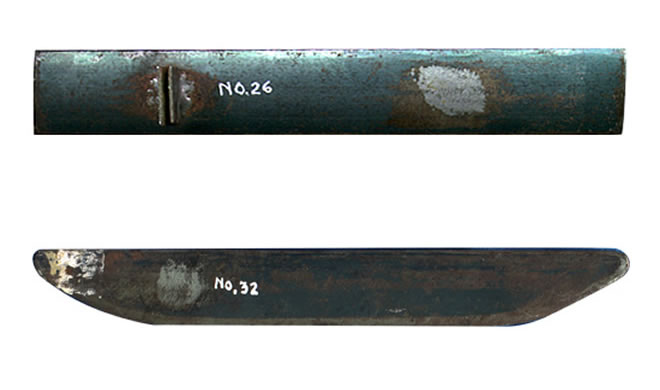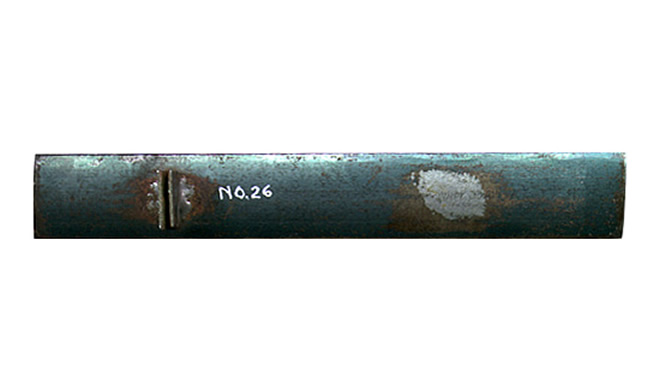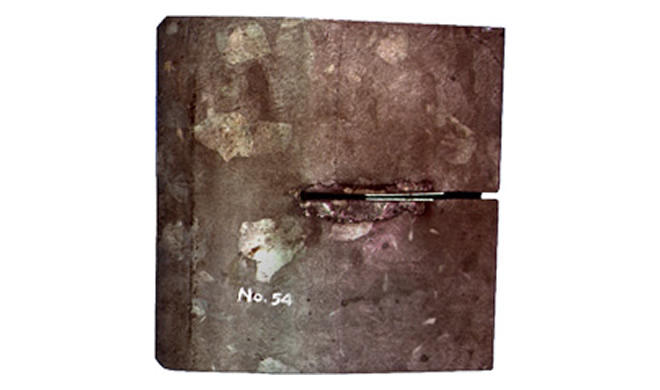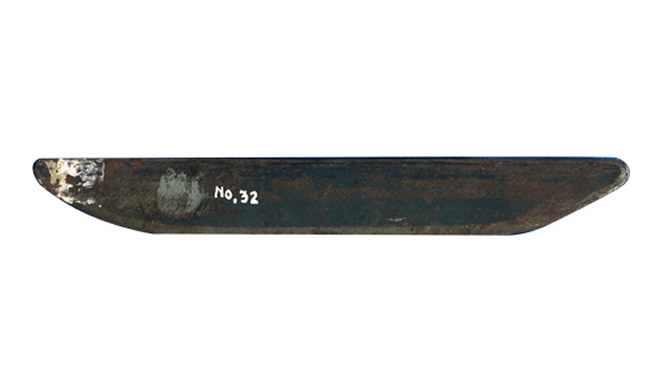
Wright Brothers' original airfoils from the Collection of The Franklin Institute
On any day, at any airport, in any city, people fly. Many people experience their "first" flight as a child or young adult. For some people, flying has become routine.
Stop for a moment and consider the wonder. How can an aircraft, loaded with people and cargo, possibly fly?
Over one hundred years ago, two brothers from Ohio first tried to answer that question. In 1901, Orville and Wilbur Wright tried to fly their first aircraft. The design, however, was not successful. While the craft did achieve liftoff, it worked only as a glider. After the failed flights at Kitty Hawk, North Carolina, they realized that it was foolish to build full-size models for testing.
They decided to approach the problem scientifically. They spent countless hours in their workshop calculating forces and experimenting with wing shapes. They built a wind tunnel to simulate flight conditions. They were the first to make precise measurements of lift and drag forces. Soon, they determined that the commonly accepted value for the coefficient of drag was too high, explaining why their "first" flight failed.

Parabolic metal airfoil, camber 1/20 chord, span = 4.5 inches, chord = .66 inches, area = 3 square inches.
They crafted model airfoils and tested them in the wind tunnel, and recorded data carefully. The objects further down the page are three of those real airfoils. Notice the subtle differences in their design. Eventually, they discovered that a long, narrow wing performed better than the short, square wing they used in the 1901 aircraft.
They used what they learned to design their next aircraft which they tested in 1902. The new aircraft stayed in the air, but they still had more work to do. They had to figure out how to control the craft, so they went back to the wind tunnel to do more experiments.

Parabolic metal airfoil, span = 3 inches, chord = 1.5 inches.
While the 1901 flight proved that humans could fly, it took two more years for the Wright brothers to determine how humans could fly safely! By December of 1903, Orville and Wilbur successfully completed their "first" flight.
Below are several quotes from the Wright brothers, testifying to the importance of scientific thinking in order to achieve new heights. The quotes are taken from the September, 1908 edition of Century Magazine.
The Wright brothers began their own investigations by first studying the existing research that was done by others.
"Having set out with absolute faith in the existing scientific data, we were driven to doubt one thing after another, till finally, after two years of experiment, we cast it all aside, and decided to rely entirely upon our own investigations. Truth and error were everywhere so intimately mixed as to be undistinguishable (sic). Nevertheless, the time expended in preliminary study of books was not misspent, for they gave us a good general understanding of the subject, and enabled us at the outset to avoid effort in many directions in which results would have been hopeless."
They soon realized, however, the "general understanding of the subject" was not good enough.
"The standard for measurements of wind-pressures is the force produced by a current of air of one mile per hour velocity striking square against a plane of one square-foot area. The practical difficulties of obtaining an exact measurement of this force have been great. The measurements by different recognized authorities vary fifty per cent. When this simplest of measurements presents so great difficulties, what shall be said of the troubles encountered by those who attempt to find the pressure at each angle as the plane is inclined more and more edgewise to the wind? In the eighteenth century the French Academy prepared tables giving such information, and at a later date the Aeronautical Society of Great Britain made similar experiments. Many persons likewise published measurements and formulas; but the results were so discordant that Professor Langley undertook a new series of measurements, the results of which form the basis of his celebrated work, "Experiments in Aerodynamics." Yet a critical examination of the data upon which he based his conclusions as to the pressures at small angles shows results so various as to make many of his conclusions little better than guess-work."
They decided to begin their own experimentation.
"To work intelligently, one needs to know the effects of a multitude of variations that could be incorporated in the surfaces of flying-machines. The pressures on squares are different from those on rectangles, circles, triangles, or ellipses; arched surfaces differ from planes, and vary among themselves according to the depth of curvature; true arcs differ from parabolas, and the latter differ among themselves; thick surfaces differ from thin, and surfaces thicker in one place than another vary in pressure when the positions of maximum thickness are different; some surfaces are most efficient at one angle, others at other angles. The shape of the edge also makes a difference, so that thousands of combinations are possible in so simple a thing as a wing."
Most fascinating, of course, is the fact that Orville and Wilbur had no formal science education.
"We had taken up aeronautics merely as a sport. We reluctantly entered upon the scientific side of it. But we soon found the work so fascinating that we were drawn into it deeper and deeper. Two testing-machines were built, which we believed would avoid the errors to which the measurements of others had been subject. After making preliminary measurements on a great number of different-shaped surfaces, to secure a general understanding of the subject, we began systematic measurements of standard surfaces, so varied in design as to bring out the underlying causes of differences noted in their pressures. Measurements were tabulated on nearly fifty of these at all angles from zero to 45 degrees, at intervals of 2 1/2 degrees. Measurements were also secured showing the effects on each other when surfaces are superposed, or when they follow one another."

Parabolic metal airfoil, camber 1/20 chord, span = 4.5 inches, chord = .66 inches, area = 3 square inches.
Before they knew it, however, they became the leading engineers of flight.
"Further corroboration of the tables was obtained in experiments with a new glider at Kill Devil Hill the next season. In September and October, 1902, nearly one thousand gliding flights were made, several of which covered distances of over 600 feet. Some, made against a wind of thirty-six miles an hour, gave proof of the effectiveness of the devices for control. With this machine, in the autumn of 1903, we made a number of flights in which we remained in the air for over a minute, often soaring for a considerable time in one spot, without any descent at all. Little wonder that our unscientific assistant should think the only thing needed to keep it indefinitely in the air would be a coat of feathers to make it light!
Like any scientist, the Wrights were putting together the pieces of the puzzle.
"With accurate data for making calculations, and a system of balance effective in winds as well as in calms, we were now in a position, we thought, to build a successful power-flyer."
The Wright brothers are just two of the many hobbyists in history who followed their devotion to extraordinary achievements. With careful investigation, anyone can discover the future!
Note: The objects pictured above are part of The Franklin Institute's protected collection of objects. The images are © The Franklin Institute. All rights are reserved.

